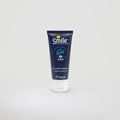Greatly forgotten in anatomy, the perineum is however essential for many functions: continence, organ support, sexuality, etc. We tell you everything about the pelvic floor!
What is the pelvic floor?
The pelvic floor is a set of muscles, ligaments and membranes. Extending from the posterior surface of the pubis until coccyx, this “hammock” plays a fundamental role :
- support and maintain the genitals.
- ensure the proper functioning of continence processes.
- regulate sexual response.

How does the perineum work?
Dr Marine Lallemant, head of clinic in obstetrics and gynecology and specialist in pelvi-perineology, explains to us. Concretely, a triple system fixes the pelvic organs:
- pelvic muscles : support system on which the pelvic organs rest.
- ligaments : suspension and anchoring of the pelvic organs on the pelvic bones.
- fascia : cohesion between these organs.
To ensure a good balance, this system must then combine flexibility And solidity. In the event of relaxation of the perineal muscles or ligaments, or intra-abdominal hyperpressure, the risks are serious.
Descent of organs (prolapse), stress urinary incontinence (urinary leakage) or anal incontinence… The most serious cases even require surgical treatment.
Both women and men have a perineum!
If women are aware of their perineum, many men are unaware that they have one. Although it is less fragile for anatomical reasons, local trauma (such as prostate surgery) can weaken it.
Therefore, we strongly recommend sessions of perineal rehabilitation upstream to anticipate the risks of post-operative incontinence. After the operation, the sessions will also avoid incontinence and erection problems.
The multiple demands on the pelvic floor
Three successive orifices make the perineum in women particularly vulnerable: the urethra, vagina and anus. Additionally, the pelvic floor muscle group undergoes permanent requests. Carrying loads, laughing, sneezing, running... He even participates in maintaining posture.
Pregnancy
First, pregnancy andchildbirth can seriously damage the pelvic floor. These events are also one of the primary causes of incontinence because:
- The baby's weight puts pressure on the perineum for several months.
- During a vaginal birth, the passage of the baby's body can relax the perineum.
This is why it is necessary to make a perineal assessment see a gynecologist or midwife after childbirth, whatever it may be.
Furthermore, it is better to pay attention to your perineum before becoming pregnant. A few strengthening exercises upstream will prepare these muscles for the 9 months of pregnancy.
Are you already pregnant? Replace pelvic floor strengthening with awareness and awareness exercises. relaxation of the perineum. They should facilitate childbirth.
Carrying heavy loads
Carrying heavy loads, i.e. bending down and getting up with effort, puts a lot of strain on the perineum. Distending it in this way can then cause urinary leakage, or even incontinence.

Smoking
Then, when smoking causes coughing fits recurrent, stress urinary leakage may occur. Coughing attacks the perineum repeatedly and in spurts, which weakens it significantly.

Constipation
Then, difficulties in passing stools and the numerous pushing efforts can traumatize the perineum. Then weakened, it no longer supports the organs and urinary leaks appear.
Note: we speak of constipation if the number of stools is less than 3 times a week for a long period of time.
Menopause
Menopause is also a critical period for the tone of the perineum. Hormonal changes and tissue aging actually cause a pelvic floor relaxation.
Without forgetting the vaginal dryness... Against all these inconveniences, perineal rehabilitation would be favorable.
Sexual intercourse
Finally, a poorly toned perineum reduces the sensations during sexual intercourse. If it is distended, the vagina encloses the man's penis less, causing a lack of sensations for both partners.
How to take care of your pelvic floor?
Like any muscle, you need to take care of your perineum and train it throughout his life. After rehabilitation with a physiotherapist or midwife, continuing at home helps maintain progress over time.
The Emy solution to strengthen your pelvic floor
First, you can use a connected perineal biofeedback probe as the Emy probe.

Healthcare professionals often use biofeedback. Unlike electrostimulation, this method does not rely on sending electrical current. The patient will contract the muscles of her perineum herself to tone more quickly and lastingly.
French medical innovation, Emy allows women of all ages to re-educate their perineum alone at home, while having fun.

Her mobile app offers 32 fun exercises based on classic medical protocols for perineal rehabilitation.
You can also re-educate your perineum at home, without the Emy vaginal probe. Download for free the app to access several mini-games and schedule your workout reminders.
Learn more about the Emy probe
Practicing a sporting activity
Then, a sports activity gentle and regular will promote a toned perineum.
In case of a weak pelvic floor, prefer gentle sports like yoga, Pilates or cycling. On the other hand, ban sports with repeated shocks or jumps (crossfit, trampoline, running, etc.).
Pay attention to your weight
Third, there is a link between urinary incontinence and excess weight. To limit the pressure on the perineum, weight loss (with professional support) would then be a solution.
Think about your posture
Finally, strengthening your perineum is insufficient in the long term if the posture is incorrect. It is therefore essential to hold correctly and adjust your posture daily to avoid excessive pressure on the organs.
Which method should you choose to re-educate your pelvic muscles?
Re-educate your perineum with electrostimulation
In addition to classic perineal rehabilitation with your healthcare professional, electrostimulation can be a solution for women who want to continue their exercises at home. In this case, it is a electrical stimulation which causes the involuntary contraction of the perineum.
This technique may not be very bearable for some who judge electrical stimulation unpleasant.
Of the perineal electrostimulation devices can be used at the healthcare professional and at home whether in the form of vaginal probe or shorty (the latter targets the pelvic floor muscles and sends a multidirectional electrical current.).
Very simply, these devices act like the electrodes that you place on your abdominals to boost muscles. They must therefore be prescribed by a health professional and their use must be done within the framework of the medical follow-up with the rehabilitator.
Strengthen your pelvic floor using biofeedback
Perineal rehabilitation using biofeedback is a self-training solution that allows you to do voluntarily work your pelvic muscles (unlike electrostimulation which is a passive rehabilitation technique).
With a biofeedback probe, it is a question of strengthen your perineum yourself.

If we return to the comparison with the abdominals, electrostimulation amounts to placing electrodes which send electrical stimulation to the muscle while biofeedback amounts to doing the abdominals by oneself. In fact, it is you who will work and contract your muscle.
The probe is only there to capture and detect your perineal contractions. It then sends this information to a computer (in the case of the healthcare professional) or to a smartphone (if you are at home).
This technology makes it possible to have a visual information on the contraction action that has just been performed. It is therefore possible to visualize voluntary contractions in real time of his perineum.

THE biofeedback probes capture the contractions exerted by the user and give the measuring your progress. This is a tool that promotes awareness perineal contractions and learning, which ultimately boosts the connection between the body and the brain.
Learn more about the Emy probe
Manual perineal rehabilitation
The perineal rehabilitation method must above all be suitable for women who will have to do several sessions before regaining a toned perineum.
There manual rehabilitation consists of performing a vaginal examination and indicating to the patient, through light pressure, on which muscle to direct its contraction. This technique makes it possible to direct your efforts towards the muscles that need to be worked the most.
Once the patient correctly contracts her perineum, a second phase of gentle exercises begins.
With the help of specific images, the patient becomes aware of the different areas of her perineum and the thrust exerted on it during an effort.
Finally, the health professional teaches his patient the rapid lifting movements to do before these efforts so that the latter considers this work as a automation.
Pelvic floor rehabilitation at home
You can also make your perineal rehabilitation at home without a device, just by downloading an application on your smartphone.
With the Emy app for example, you can work on your perineal contractions via different types of fun exercises, modeled on the medical protocols used by health professionals (long, short, rapid contractions, to be maintained over time, etc.).

To summarize, biofeedback is a method classically used by rehabilitators and which complements electrostimulation.
Furthermore, biofeedback technology is not based on the sending of electric current (unlike electrostimulation) and makes it possible to observe results faster and more lasting on the tone of the perineum.
With Emy medical innovation, it is now possible to tone your perineum at home while having fun. It took 2 years of research and development to offer a biofeedback probe with dimensions similar to those found among health professionals and which adapts to the needs and expectations of women.
Learn more about the Emy probe
They tested and adopted Emy
Since using Emy, I've come back to life! Several months ago, I was unable to contract my perineum and today I am regaining my muscle tone. 5 minutes a day is enough!
Cécile, 35 years old, Emy user
I found Emy: fun and playful. I am absolutely certain that women will continue to do their rehabilitation with this device which is completely innovative.
Odile Bagot, obstetrician-gynecologist in Strasbourg
First of all, I noticed that I didn't have to change my period pad several times a day. Today I would say that leaks have been divided by 5. When you think about the price of sanitary napkins, it’s an incredible saving.
Marie-Pierre, 46 years old, Emy user
I first discovered the free application which I already found very good, I did my exercises every day or every 2 days. Then, when I discovered that there was a probe, I didn't hesitate long before buying it! Thanks to the application and the probe I was able to avoid an operation that could have been very cumbersome
Eve, 62 years old, Emy user







